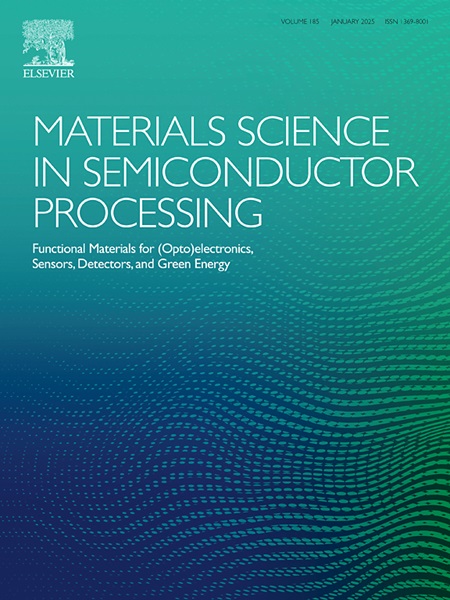Thermodynamic stability and optoelectronic properties of rock salt MgSxO1-x ternary alloys through (TB-mBJ) approach: For ultra-violet detection
IF 4.2
3区 工程技术
Q2 ENGINEERING, ELECTRICAL & ELECTRONIC
引用次数: 0
Abstract
In this work, we investigated the thermodynamic stability and optoelectronic properties of MgSxO1-x (0≤x ≤ 1) ternary alloys in rock salt phase. These properties have been carefully described using the full-potential linearized augmented plane wave (FP-LAPW) formalism within the framework of density functional theory (DFT). Structural properties and total energies of MgSxO1-x ternaries have been calculated using generalized gradient approximation of Wu and Cohen (WC-GGA) approach for different concentrations (x). It is found that the calculated lattice constant of MgSxO1-x ternaries increases with increasing sulfur (S) concentrations while its bulk modulus decreases. Based on the regular solution model, we have determined the thermodynamic stability of MgSxO1-x. In addition to (WC-GGA), we used the Becke-Johnson approach modified by Tran-Blaha (TB-mBJ). To explore the potential of MgSxO1-x ternary alloys in rock salt phase for optoelectronic applications, we have calculated and analyzed their optical properties in detail in the energy range of 0–50 eV. Our obtained results predict that MgSxO1-x ternary alloys can be effectively used in optical devices operating in the ultraviolet (UV) spectrum.
通过(TB-mBJ)方法研究岩盐 MgSxO1-x 三元合金的热力学稳定性和光电特性:用于紫外线探测
在这项工作中,我们研究了岩盐相 MgSxO1-x (0≤x ≤ 1) 三元合金的热力学稳定性和光电特性。我们在密度泛函理论(DFT)框架内采用全电位线性化增强平面波(FP-LAPW)形式对这些性质进行了仔细描述。利用吴和科恩的广义梯度近似(WC-GGA)方法计算了不同浓度(x)的 MgSxO1-x 三元体的结构特性和总能。结果发现,随着硫(S)浓度的增加,计算得到的 MgSxO1-x 三元体的晶格常数也随之增加,而其体积模量则有所降低。根据正则溶液模型,我们确定了 MgSxO1-x 的热力学稳定性。除了(WC-GGA)之外,我们还使用了经 Tran-Blaha 修正的贝克-约翰逊方法(TB-mBJ)。为了探索岩盐相 MgSxO1-x 三元合金在光电应用方面的潜力,我们详细计算并分析了它们在 0-50 eV 能量范围内的光学特性。结果表明,MgSxO1-x 三元合金可以有效地应用于紫外(UV)光谱下的光学设备。
本文章由计算机程序翻译,如有差异,请以英文原文为准。
求助全文
约1分钟内获得全文
求助全文
来源期刊

Materials Science in Semiconductor Processing
工程技术-材料科学:综合
CiteScore
8.00
自引率
4.90%
发文量
780
审稿时长
42 days
期刊介绍:
Materials Science in Semiconductor Processing provides a unique forum for the discussion of novel processing, applications and theoretical studies of functional materials and devices for (opto)electronics, sensors, detectors, biotechnology and green energy.
Each issue will aim to provide a snapshot of current insights, new achievements, breakthroughs and future trends in such diverse fields as microelectronics, energy conversion and storage, communications, biotechnology, (photo)catalysis, nano- and thin-film technology, hybrid and composite materials, chemical processing, vapor-phase deposition, device fabrication, and modelling, which are the backbone of advanced semiconductor processing and applications.
Coverage will include: advanced lithography for submicron devices; etching and related topics; ion implantation; damage evolution and related issues; plasma and thermal CVD; rapid thermal processing; advanced metallization and interconnect schemes; thin dielectric layers, oxidation; sol-gel processing; chemical bath and (electro)chemical deposition; compound semiconductor processing; new non-oxide materials and their applications; (macro)molecular and hybrid materials; molecular dynamics, ab-initio methods, Monte Carlo, etc.; new materials and processes for discrete and integrated circuits; magnetic materials and spintronics; heterostructures and quantum devices; engineering of the electrical and optical properties of semiconductors; crystal growth mechanisms; reliability, defect density, intrinsic impurities and defects.
 求助内容:
求助内容: 应助结果提醒方式:
应助结果提醒方式:


